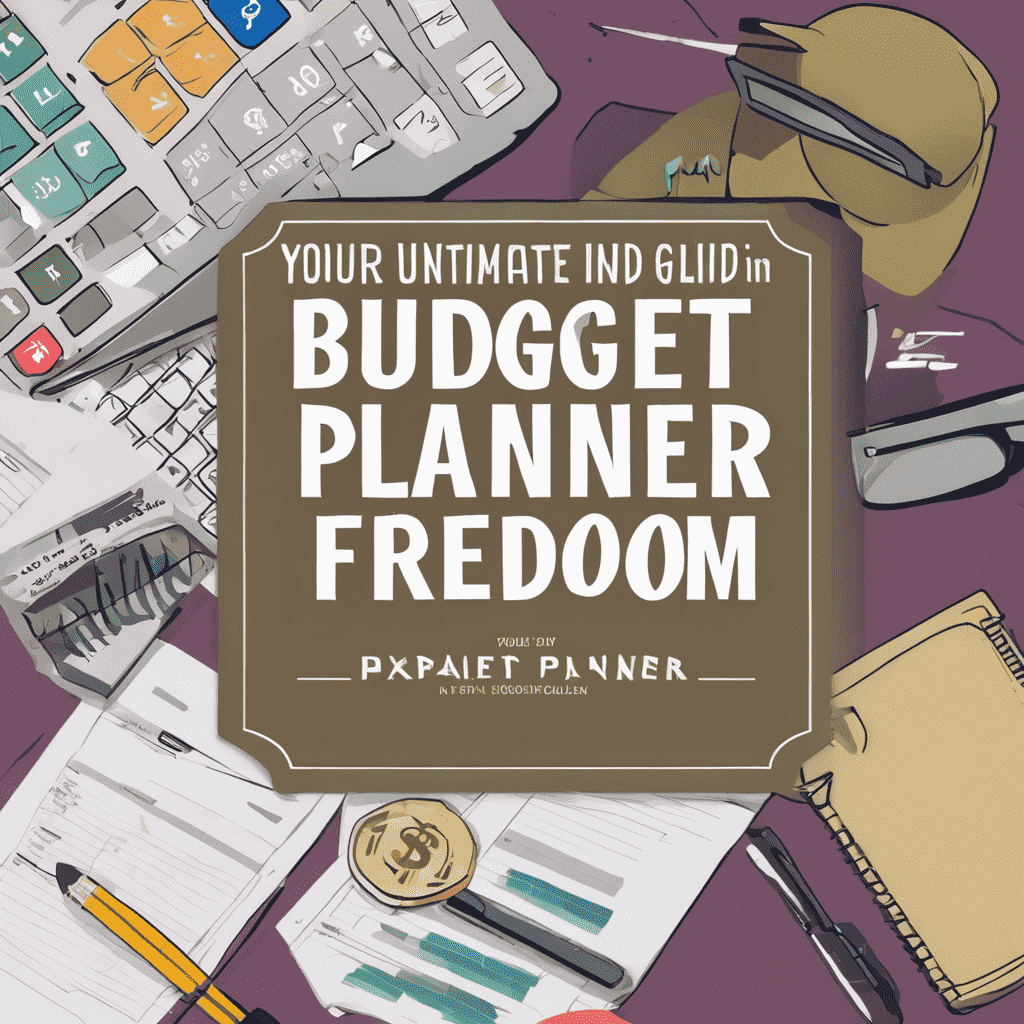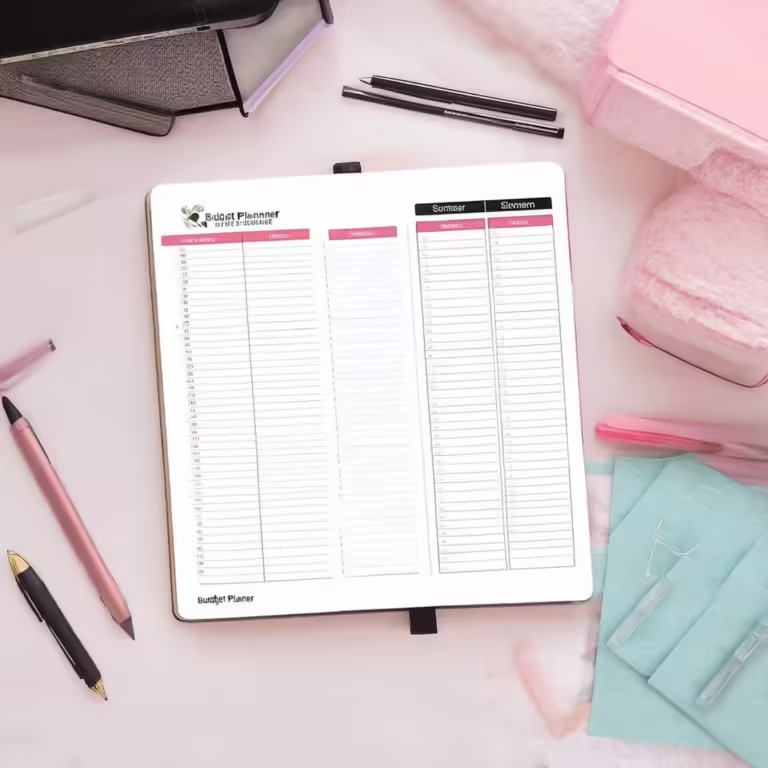Table of Contents
Introduction
Are you ready to take control of your finances and achieve your dreams? A budget planner is your secret weapon for financial success. Whether you’re saving for a down payment, paying off debt, or simply want to spend more intentionally, the right budget planner can make all the difference.

In this comprehensive guide, we’ll dive into the world of budget planners, exploring the various types available, essential features to consider, and how to match a planner to your individual budgeting style.
Types of Budget Planners: Finding Your Perfect Match
The key to successful budgeting is consistency, and the best way to stay consistent is to use a planner that seamlessly integrates with your lifestyle. Let’s delve deeper into the most popular types:
1. Digital Budget Planners
- Who They’re For: Tech enthusiasts, those who prefer on-the-go access, individuals who want automation.
- Pros:
- Convenience: Easily accessible through smartphone apps or web platforms.
- Automation: Often connect to bank accounts for automatic transaction syncing, eliminating manual entry.
- Real-time Insights: Provide instant feedback on spending habits and budget progress.
- Additional Features: May offer bill reminders, investment tracking, credit score monitoring, and financial goal setting.
- Popular Examples: Mint, YNAB (You Need A Budget), EveryDollar
- Things to Consider: Requires comfort with technology and may involve sharing financial information with a third-party app.
2. Printable Budget Planners
- Who They’re For: Those who prefer a hands-on approach, visual learners, individuals who want to customize their planner.
- Pros:
- Tangibility: Physical interaction can be more satisfying for some.
- Customization: You can tailor the layout, categories, and design to your liking.
- Budget-Specific Templates: Many free or paid printables are available online with pre-designed budget sections.
- Affordability: Often free or low-cost to download and print.
- Cons: Requires manual data entry, less portability than digital options.
3. Notebook Budget Planners
- Who They’re For: Those who like flexibility and enjoy writing things down.
- Pros:
- Adaptability: Can be used with any notebook, allowing you to create your own system.
- Creativity: Freedom to design your layouts, use colors, and personalize.
- Templates: Many notebooks come with pre-printed budget pages or you can purchase budget-specific inserts.
- Cons: Requires manual data entry and may not have as many features as digital options.
4. All-in-One Financial Planners
- Who They’re For: Individuals looking for a holistic approach to financial planning, those who want to track investments and other assets alongside their budget.
- Pros:
- Comprehensive: Goes beyond budgeting to include retirement planning, investment tracking, net worth calculations, and more.
- Long-term Focus: Helps you envision your financial future and stay on track.
- Cons: Can be more complex than simple budget planners, may not be necessary for those who only need budgeting tools.
- Popular Examples: Personal Capital, Quicken
Essential Features: What to Look for in Your Budget Planner
Choosing a budget planner with the right features can make a significant difference in how effectively you manage your money. Here’s what you should prioritize:
- Income Tracking
- Why it’s Essential: Clearly recording all sources of income provides a complete picture of your financial resources. This includes your salary, side hustles, investment income, and any other money you receive.
- What to Look For: A clear interface to input income sources, the ability to track recurring income (e.g., bi-weekly paychecks), and the option to add additional income streams as needed.
- Expense Tracking
- Why it’s Essential: The heart of any budget is expense tracking. By categorizing your spending, you’ll identify areas where you can potentially cut back and save money.
- What to Look For: Customizable spending categories to fit your lifestyle, the ability to track individual transactions, and the option to link expenses to specific accounts or payment methods.
- Debt Management Tools
- Why it’s Essential: If you have debt, it’s crucial to have tools that help you track progress towards becoming debt-free. This can be motivating and help you prioritize payments.
- What to Look For: Debt trackers that show outstanding balances, minimum payments, interest rates, and payoff timelines. Some planners offer debt snowball or debt avalanche methods to accelerate your progress.
- Goal Setting
- Why it’s Essential: Setting financial goals provides direction and purpose for your budgeting efforts. Whether it’s saving for a down payment, paying off student loans, or building an emergency fund, clear goals keep you motivated.
- What to Look For: A goal-setting feature that lets you define specific targets, track progress, and adjust deadlines as needed. Visual representations (like progress bars) can be particularly helpful.
- Financial Reports
- Why it’s Essential: Visual summaries of your spending habits can provide valuable insights you might miss when looking at individual transactions.
- What to Look For: Pie charts, bar graphs, or other visual reports that break down your spending by category, time period, or other criteria. This helps you see where your money is going at a glance.
- Bill Payment Reminders
- Why it’s Essential: Staying on top of bill due dates is crucial to avoid late fees and maintain a good credit score.
- What to Look For: Customizable reminders that can be set for specific bills or recurring payments. Some apps even offer the ability to pay bills directly through the platform.
- Customizable Categories
- Why it’s Essential: Every person’s spending habits are unique. Having the flexibility to tailor your budget categories ensures you can track your spending in a way that makes sense to you.
- What to Look For: The ability to create, modify, and delete categories as needed. Look for planners that offer a wide range of default categories or allow you to start from scratch.
Finding Your Budget Planner Soulmate: A Personalized Approach
Choosing a budget planner isn’t a one-size-fits-all situation. It’s about finding a tool that aligns with your personality, preferences, and financial aspirations. Here’s how to make a match made in budgeting heaven:
1. Define Your Budgeting Style
- Micromanager: If you thrive on details and enjoy tracking every penny, a digital planner with extensive categorization and transaction logging might be your best friend.
- Big-Picture Thinker: Prefer to focus on the overall trends and less on minutiae? A simple printable with broad categories or a visual app that highlights spending patterns might suit you better.
- Hybrid Approach: Many people find a combination works best – using a digital tool for automatic tracking and a notebook for additional notes, goals, or reflections.
2. Assess Your Tech Comfort Level
- Tech-Savvy: Embrace the convenience and automation of digital apps with features like bank syncing, spending alerts, and investment tracking.
- Pen-and-Paper Enthusiast: Enjoy the tactile experience of writing and the freedom to customize. Choose a printable budget planner or a simple notebook with dedicated sections for budgeting.
- Somewhere in Between: Explore hybrid options like digital apps that offer printable summaries or notebooks with companion apps for additional insights.
3. Identify Your Financial Goals
- Debt Crusher: Look for planners with debt payoff trackers, interest calculators, and visualization tools to stay motivated.
- Saver Extraordinaire: Choose a planner with goal-setting features, progress tracking, and perhaps even investment options to help your money grow.
- Balanced Approach: If you have multiple goals (e.g., saving for a house while paying down debt), opt for a planner that allows you to track multiple goals simultaneously.
4. Determine Your Desired Level of Detail
- Itemized Every Purchase: A digital app or detailed printable will help you track every coffee, subscription, and impulse buy.
- Broad Strokes: If you prefer to categorize spending into broader buckets (e.g., groceries, transportation, entertainment), a simpler printable or an app with visual spending summaries might be sufficient.
- Somewhere in the Middle: Many planners allow you to customize the level of detail, so you can choose how granular you want to get.
Additional Tips for Finding Your Perfect Match
- Try Before You Buy: Many digital apps offer free trials, and printable planners often have sample pages to test out.
- Read Reviews: See what other users have to say about different planners to get insights into their pros and cons.
- Ask for Recommendations: Talk to friends, family, or financial advisors to see what tools they use and find helpful.
- Don’t Be Afraid to Switch: If your needs change or you find a planner isn’t working for you, don’t hesitate to explore other options.
Tips for Effective Budgeting
Creating a budget is just the first step. The real magic happens when you implement strategies to maximize its effectiveness. Here’s how to make your budget work for you:
- Set SMART Financial Goals
- Specific: Define your goals clearly. Instead of saying, “I want to save more,” say, “I want to save $5,000 for a down payment on a car within 12 months.”
- Measurable: Quantify your goals so you can track progress. How much do you need to save each month to reach your target?
- Achievable: Be realistic. Setting overly ambitious goals can lead to frustration and discouragement.
- Relevant: Ensure your goals align with your values and priorities. What truly matters to you financially?
- Time-Bound: Set a deadline for achieving your goals. This creates a sense of urgency and helps you stay focused.
- Track Every Penny (Even the Pennies!)
- The Latte Factor: Those small, daily expenses can add up surprisingly fast. Track every coffee, snack, or ride-share to understand where your money goes.
- Cash vs. Card: If you tend to overspend with cards, try using cash for discretionary spending to create a visual and tangible limit.
- Automate Tracking: Many digital budget planners can sync with your bank accounts, automatically categorizing your spending. This saves time and ensures accuracy.
- Regularly Review and Reflect
- Monthly Check-Ins: Dedicate time each month to review your budget’s performance. Did you stick to your plan? Are there any categories where you overspent?
- Quarterly Analysis: Take a deeper dive every three months to assess progress towards your goals. Are you on track? Do you need to adjust your targets?
- Annual Evaluation: At the end of the year, reflect on your overall financial progress. Celebrate your wins and identify areas for improvement.
- Embrace Flexibility
- Life Happens: Unexpected expenses, income fluctuations, or changes in priorities are inevitable. Your budget should be adaptable, not rigid.
- Reassess Regularly: As your circumstances change, so should your budget. Review it regularly to ensure it still aligns with your goals and needs.
- Don’t Give Up: If you overspend one month or face a setback, don’t throw in the towel. Get back on track and use the experience as a learning opportunity.
- Celebrate Your Wins (Big and Small)
- Stay Motivated: Rewarding yourself for reaching milestones reinforces positive behavior and keeps you engaged in the budgeting process.
- Celebrate Progress, Not Perfection: Even small wins, like sticking to your grocery budget for a month or paying off a credit card, deserve recognition.
- Get Creative: Rewards don’t have to be expensive. They could be a movie night, a special dinner, or a relaxing activity you enjoy.
By incorporating these tips into your budgeting routine, you’ll transform your budget from a simple tracking tool into a powerful instrument for achieving your financial dreams. Remember, budgeting is a journey, not a destination. Embrace the process, stay adaptable, and celebrate your progress along the way!
Conclusion
Choosing the perfect budget planner is the first step towards a brighter financial future. By understanding the different types of planners, essential features, and how to match them to your individual needs, you’ll be well-equipped to take control of your money and achieve your goals.
Remember, the best budget planner is the one you’ll actually use. Start exploring your options today, and embrace the journey towards financial freedom!
Read our beginners guide here: The Ultimate Guide to Budgeting for Beginners (2024 Edition)







